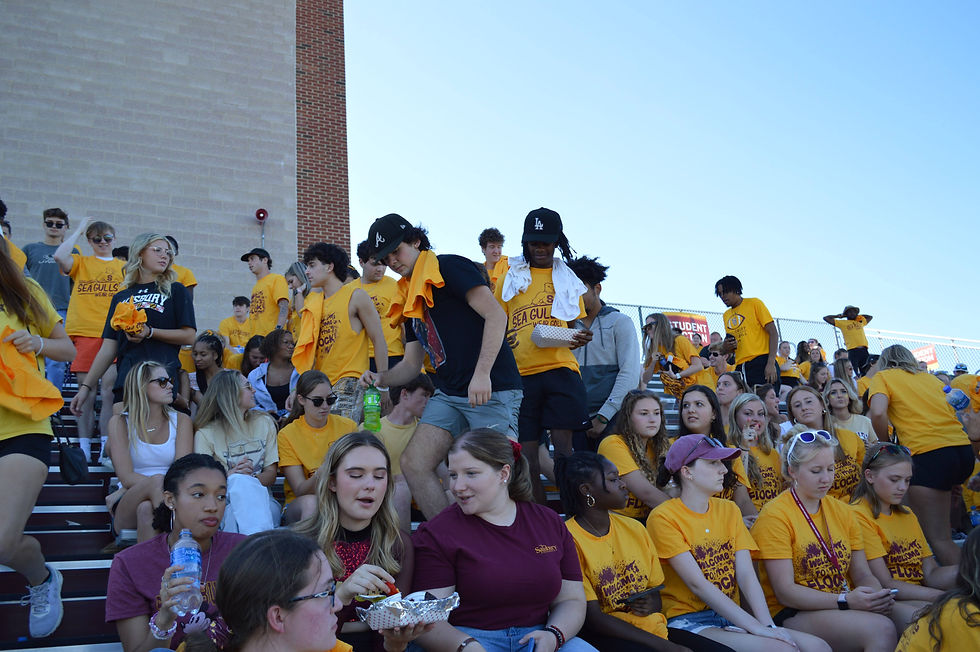Pocomoke historical presentation at SU attracts large audience
- Colin McEvers

- Nov 9, 2023
- 3 min read

Rooted in the historical fabrics of the eastern shore region are the Native tribes which once inhabited the land. A few days into Native American Heritage month, Salisbury University hosted a historical presentation event in partnership with the Pocomoke Indian Nation on Nov. 3rd to highlight the traditions of Delmarva's native tribes.
Since its federal implementation over three decades ago, Native American Heritage month has been used as an opportunity by various tribes, organizations and academic institutions across the US to recognize the history and contributions made by American Indians.
The main initiative of the event was to educate the local community about eastern shore Indian modes of life and traditional practices at the time Europeans such as Captain John Smith arrived in the Americas.
Names of the tribes which once resided in the Salisbury area and its surrounding region (Pocomoke, Nanticoke, Wicomico and more) are commonplace, yet most people know little about their historical background.
Buddy Howard, son of Pocomoke Indian Chief Norris Howard Sr, has a passion for indigenous history that he’s used to make presentation events extremely informative.

“We’re a descendant community of the Pocomoke Indian nation, [a] local tribe in the lower eastern shore.” Howard said. “We’re here tonight to relate the history of that tribe as well as illustrate, or demonstrate, a number of tangible objects that would have been in [use] when Europeans first came here to the eastern shore.”
“We feel it’s important for people, for the public in general to know the land that they’re on – who it was occupied by, when, what these people went through in terms of contact with early Europeans as well as the skills and necessary objects they needed to survive here.”
The people and groups responsible for organizing the event gave members of the Pocomoke tribe, including Howard and the cultural ambassador Drew Shuptar-Rayvis, a platform to share knowledge pertaining to early American interactions between Natives and Europeans.
Celine Carayon, who has a doctorate in History and teaches Native American History courses, has worked towards putting together a multitude of informative November events at SU for over a decade.

“We worked really hard in partnership with local communities like the Pocomoke and the Nanticoke [tribes] and other groups locally,” Carayon said.
Originally from France, Carayon came to the US to study early American history and became particularly interested in the encounters which indigenous groups had with European settlers.
“I believe Native people are really a part of [early American] history; it’s not separate, it’s part of American history and we need to know about it,” she said. “I think it’s very significant to tell people that this land has a very long and ancient history.”
As the presentation of historical maps, documents and records of the lower eastern shore came to a close, the attendees prepared to see the anticipated re-enactment. Displayed on a table were models of objects used by the 17th century Delmarva tribes, around the time European colonization began.
Drew Shuptar-Rayvis, the Pocomoke's cultural ambassador since 2021 and a historical re-enactor, was the event's key appeal. Clothed in indigenous attire, he gave the audience insight into tribal ways of life and relations with Europeans through the 1600s.

“I think one of the big things that is important is to have students – because you have a broad student base from all over the country and really all over the southern mid-atlantic region – to understand that there are indigenous communities in SU’s backyard," he said.
Shuptar-Rayvis has been a re-enactor for ten years and sees the recent SU event as a way to promote the history and cultural presence of the Pocomoke tribe, one of Maryland's six tribal communities.
"Native people are not static; indigenous Americans are here and they’re present within the Salisbury community," he said. "[They] didn’t go away, they’re right here and we’ve maintained that presence.”
By COLIN McEVERS
Office Manager
Featured images courtesy of Colin McEvers





Comments